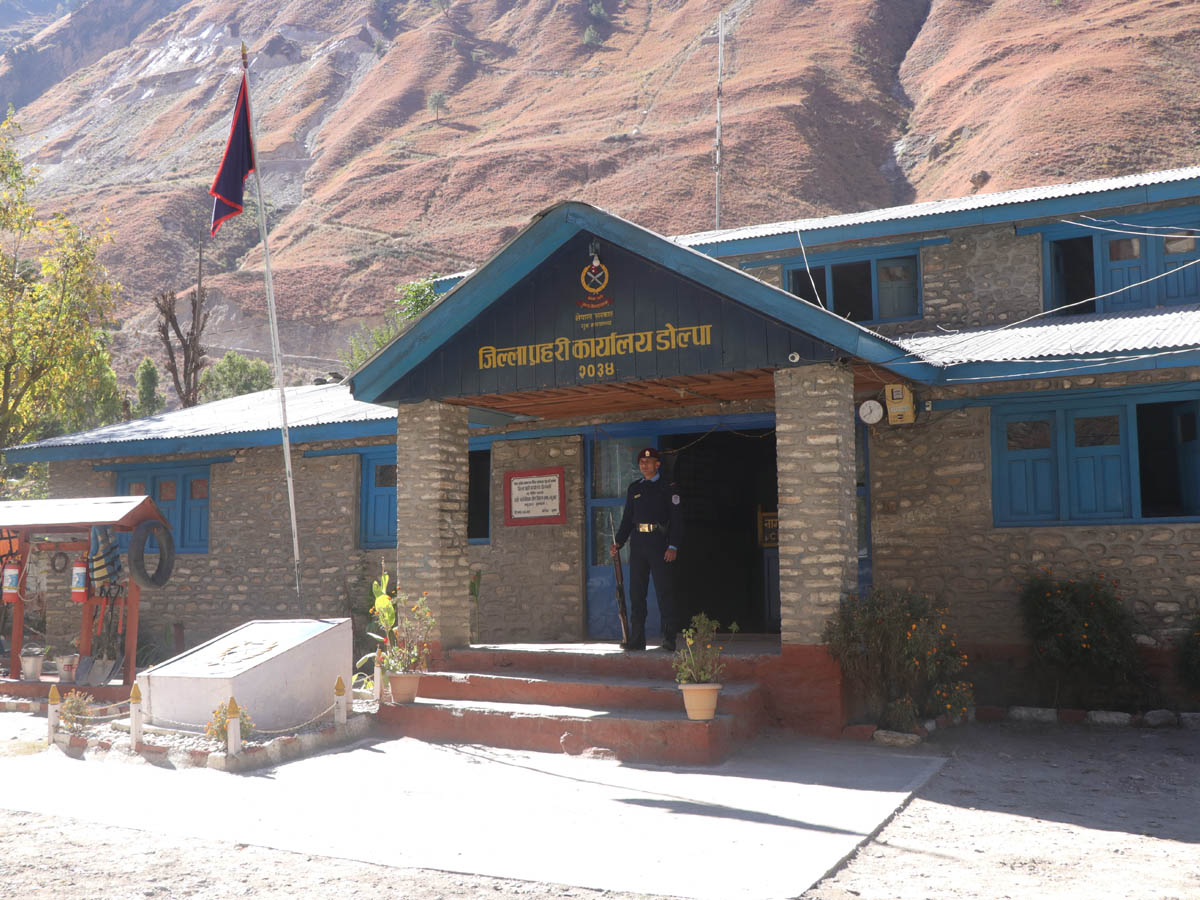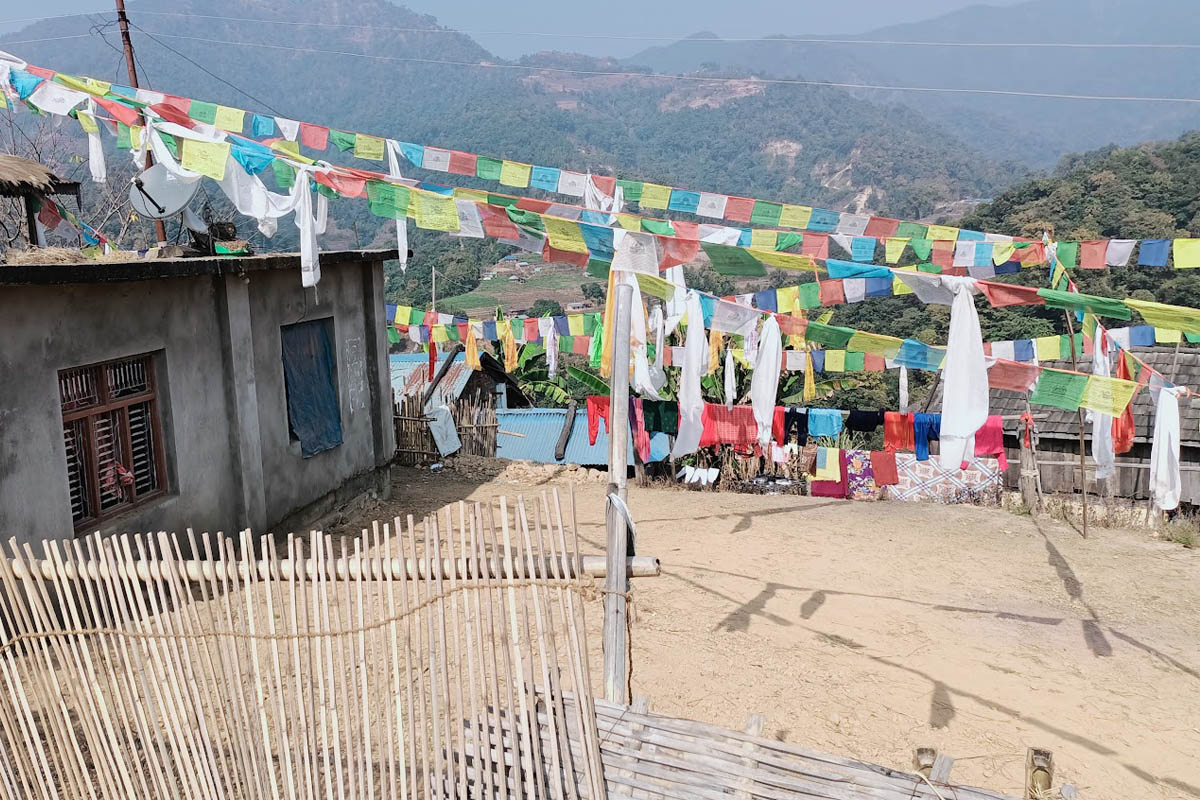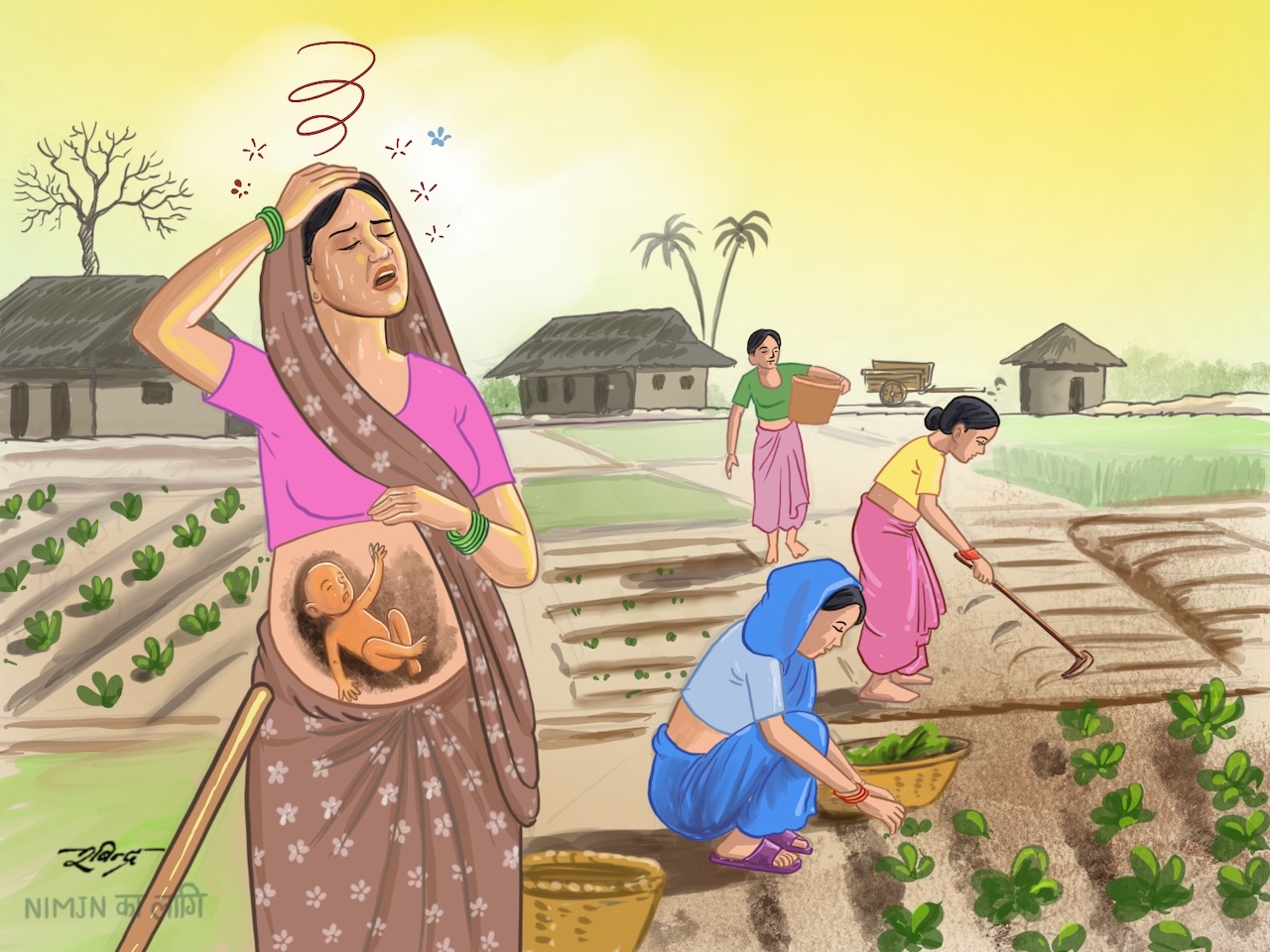To the south, majestic mountain peaks rise – Nilgiri, Tilicho, Manang, Damodar Himal, Sail, Gaugiri, Lugula, and others. To the southwest, towards the China border, the Chuama range, Chungen, Ghyu and Mansayal mountains are visible. From the south, the elevation gradually decreases northward, revealing mud hillocks. The weather is dry and cold, with a stark landscape devoid of plants, shrubs, and greenery.
 This is Upper Mustang, a majestic valley nestled in the lap of the Himalayas. Here lies Lo Manthang, a settlement enclosed by mud walls, after which the rural municipality is named. Within this settlement stands the Lo Manthang palace.
This is Upper Mustang, a majestic valley nestled in the lap of the Himalayas. Here lies Lo Manthang, a settlement enclosed by mud walls, after which the rural municipality is named. Within this settlement stands the Lo Manthang palace.
The topography of Lo Manthang and the neighboring Loghekar Damodar Kunda Rural Municipality shares similarities. Caves, carved into the rocks by humans centuries ago, hold historical and architectural significance. Archeologists suggest that available materials indicate these caves date back to the Neolithic Age – a period defined by the Nepali encyclopedia as preceding the Bronze Age and following the Middle Ages, characterized by the use of stone tools and weapons.
The Buddhist gumbas that grace the palace and caves further enhance the historical and architectural significance of the area. The gumbas, palaces and individual homes are constructed with traditional and historical architectural styles, making Lo Manthang renowned both in Nepal and internationally for these monument-like structures.
However, this centuries-old settlement and its cultural heritage are facing the imminent threat of collapse due to the impacts of climate change. Locals express deep concern that not only the architectural heritage but the very existence of Upper Mustang could be jeopardized, a possibility supported by available studies and research.
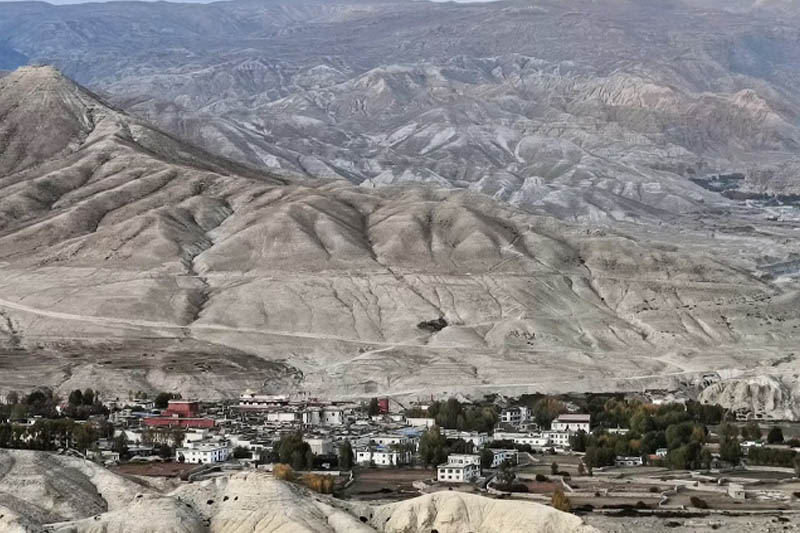
In 2008, the government of Nepal recommended that Upper Mustang be listed as a heritage site by the United Nations Educational, Scientific and Cultural Organization (UNESCO). UNESCO defines heritage as ‘our legacy from the past, what we live with today, and what we pass on to future generations’. According to UNESCO, our cultural and natural heritage is an irreplaceable source of life and inspiration. Cultural heritage encompasses more than just artifacts or materials; it includes the language, skills, and identity of local communities passed down through generations. Heritage serves as a mirror, allowing us to understand lifestyles and cultures, and it provides insight into social evolution from its origins to the present day.
Climate change impacts, such as decreasing snowfall, rising temperatures, more frequent rainfall, and melting snow, are emerging as significant threats that could devastate the ancient culture, civilization, and identity of Mustang. This has already resulted in both economic and non-economic losses in the region.
Climate change has inflicted both economic and non-economic losses and damage upon Upper Mustang. According to the UN Convention on Climate Change 2012, non-economic losses encompass, among other things, the loss of territory, cultural heritage, indigenous or local knowledge, societal or cultural identity, and the loss of biodiversity or ecosystem services.
Upper Mustang is currently confronting these very challenges.
Mud house on the verge of collapse
Due to the Annapurna-Dhaulagiri Himalayan range obstructing monsoon clouds, Mustang often experiences a rain shadow effect, resulting in dry, cold winds. The traditional houses in Mustang are constructed with raw bricks designed to withstand snow, rain, and cold winds. The roofs are also made of mud, and to prevent rain from washing it away, firewood is stacked along the edges. These houses embody the identity of Mustang's residents. Although their ancestors inhabited caves, their descendants transitioned to building these mud houses.
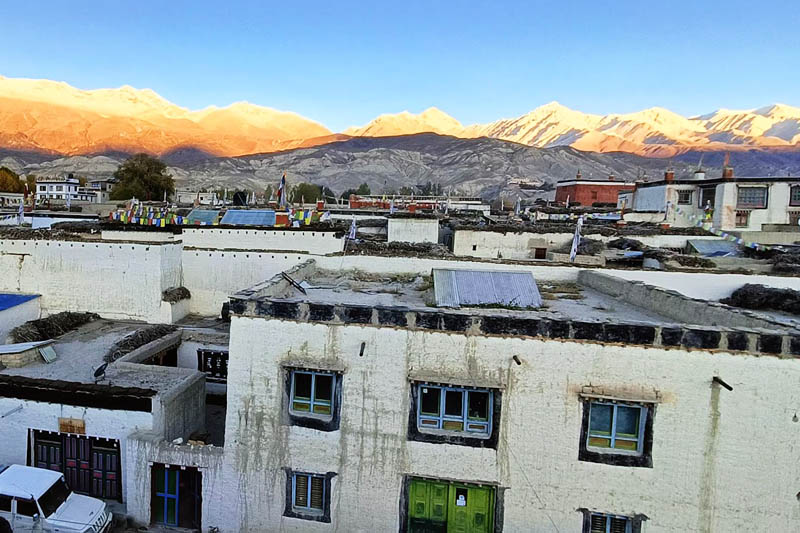
These traditional houses are resilient to snow and rain. Constructed using local resources, indigenous skills, knowledge, and technology, they also contribute to maintaining the local climate and environment. However, these aesthetically pleasing houses of significant architectural value are beginning to suffer the consequences of climate change – increasing droughts and irregular, unnatural rainfall are gradually eroding the roofs and walls.
According to Chhwang Rinjin Lowa, a ward member of Lo Manthang Rural Municipality-5, locals are finding it difficult to preserve the indigenous knowledge, skills, and architecture passed down by their ancestors, as well as the houses built using this knowledge. Lowa, himself a skilled artisan in constructing these traditional houses, explains that their foundations are laid with stones, similar to houses in the hills, but the walls above ground are built with brick-like materials made by pressing sticky mud into wooden frames. Unlike bricks in the plains and valleys that are kiln-fired, these bricks in Mustang are sun-dried for a week to ten days. Once the bricks are in place, the walls are coated with a sticky mud mixture both inside and out, making them as strong as the cement walls of concrete houses.
According to Lowa, traditional palaces, houses, schools, gumbas, and other community buildings in Upper Mustang are constructed using this traditional engineering. The houses in Mustang utilize the same type of wood – bhote pipal – for windows, doors, beams, pillars, and roofs. Thus, the bhote pipal tree species essentially sustains the structural integrity of these houses. To adapt to modernization and climate change, locals have started incorporating cement concrete pillars in new constructions, using interlocking bricks instead of traditional raw bricks. For roofing, they employ wooden beams, upon which plywood is placed, followed by zinc sheets or plastic, and finally, the surface is coated with mud again to prevent leaks. Locals express concern that this adaptation of traditional technology poses a risk of displacing indigenous skills.
"The negative impacts of climate change, which are not our fault, have become evident in Mustang," stated Lopsang Chhompel Bista, the chair of Loghekar Damodarkunda Rural Municipality. "While there might be an immediate impact in the short term, the fear is that in one or two hundred years, the identity and appearance of Mustang will vanish entirely."
Saubhagya Pradhananga, the Director General of the Department of Archaeology, mentioned that preparations are underway to develop guidelines for future infrastructure construction, taking into account the impacts of climate change on the cultural settlements of Upper Mustang. Although mud itself is not an insulating material, it possesses thermal mass, allowing it to absorb heat and cold rather than transmitting it, thereby keeping houses cool in the summer and warm in the winter. Stone and cement cannot fulfill this function.
Based on the specific heat capacity of materials, objects that heat up quickly also cool down quickly, and objects that heat up slowly cool down slowly. This explains why houses built with RCC (Reinforced Concrete Cement) technology tend to be excessively hot in summer and extremely cold in winter, according to Bishnu Paudel, the chief engineer at the Infrastructure Development Office of Myagdi. He suggests that ‘making walls thicker and using wood powder instead of sand for plastering can help keep houses warm during winter’.
Devendra Bhattarai, archeologist with Department of Archeology, says that though the residents of Mustang have been building expensive concrete houses to keep themselves safe from climate change impacts, there are concerns that such houses are not environment-friendly. Indradhara Bista, local politician and leader, says that in extremely cold places like Mustang, RCC houses are inappropriate not only from cultural and economic perspectives but also from a health perspective. He says this has raised the prospect of identity loss.
A dog guards the palace

Lo Manthang, also called a tasi lhundub in local language, is a major tourist attraction in Upper Mustang. The five-story palace, which lies in Lo Manthang Rural Municipality-5, was built by the first king of Lo Manthang, Ama Pal, in 1440. The palace, renovated after it was destroyed by 2015 earthquakes, however, stands unoccupied and unused. The palace, now under the ownership of cultural king of Mustang, Jigme Sigme Parbal, was renovated with the assistance from his family and the locals. When Bista comes to Mustang, which he does occasionally, he stays in the part that was not damaged by the earthquake. Bista has opened a resort named Royal Mustang Resort, outside the old settlement of Upper Mustang.
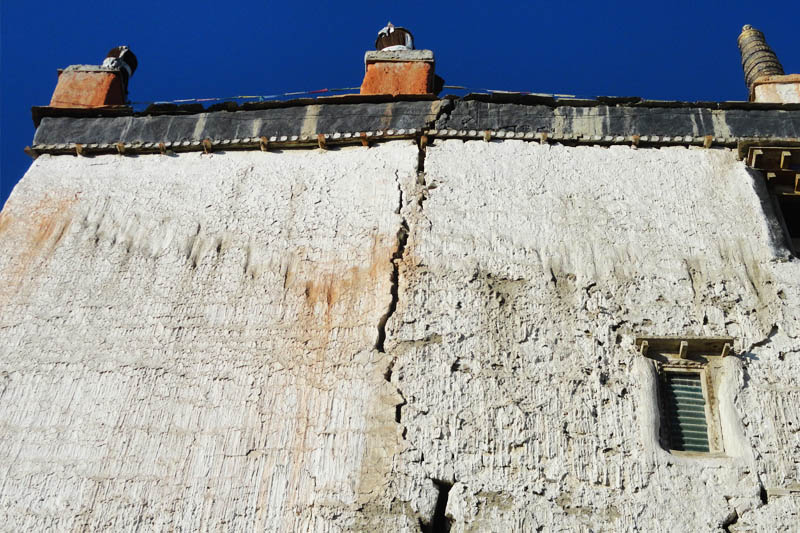
A caretaker has been assigned to guard and maintain the palace, and he also feeds the sheepdog that primarily watches over the premises. Locals say that when the caretaker is away, it is this dog that truly guards the palace. Palaces also exist in places like Ghami, Charang, and Thegar, all featuring Tibetan roof styles. However, these palaces, owned by the former Mustang king, have fallen into disrepair and become like ghost houses due to lack of use, protection, and renovation. Several sections of these palaces have crumbled. Changes in humidity, temperature, and light, all consequences of climate change and global warming, have resulted in decreased snowfall and increased rainfall, causing the mud walls to become saturated. These palaces are on the verge of collapse.
Ancient civilization under threat
Caves, called fug in local language, are central to the religious and social life of people of Lo Manthang and Mustang. These unique caves evoke mystery about the history of ancient Mustang. These caves made by breaking hard rocks are a unique heritage. Annapurna Conservation Area Project (ACAP) estimates that around 100 such man-made caves exist in different parts of Mustang. The caves in Jhong, Marchung, Niphu, Garphung, Luri, Chunsi, Chhyojong, Medrak, Chaile, Chhuksang, Tuksche, Kowang and Samjong are the major ones. Jhong cave, with five storeys and 150 rooms, is a major attraction for visiting tourists. Folklore says these caves were used as shelters by the Lamas and Jhumas. It is said that long ago, villagers would seek refuge in these caves, hiding from bandits who came from Tibet after destroying the path to the caves. Another local belief suggests that religious leaders of Buddhism created the caves by carving into the rocks for meditation, prayer and scholarly pursuits. Chhimi Gurung, an 89-year-old resident of Lo Manthang, recounts, "Such caves were made to protect religion from Tibetan looters and to ensure that religious leaders could attain enlightenment."
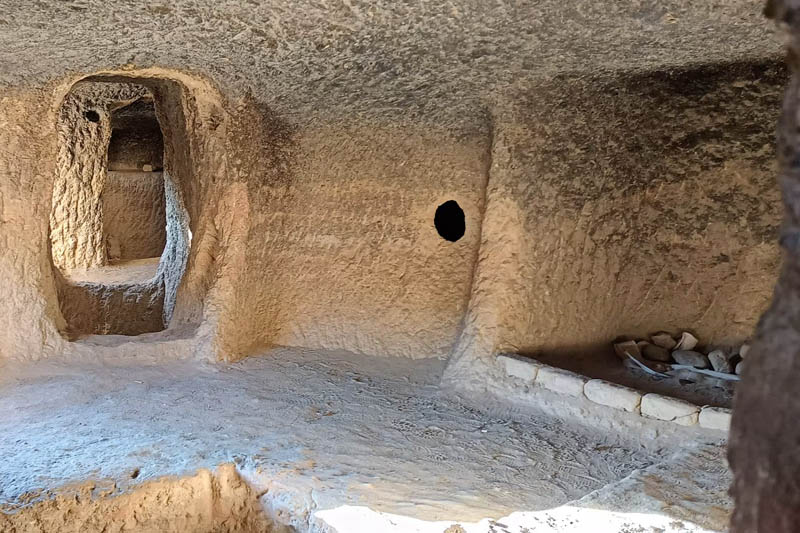
During their exploration of ancient civilization in Mustang (from 1992-1997), German and Nepali archaeologists had found a ‘child mummy’ in Mebrak cave. According to the DNA record of the Department of Archeology, the skeleton of the child was around 2,414 years old. Studies have concluded that people lived in these caves until 8th century BC and these caves have been in existence since the Stone Age.
Dr. Madan Lamsal, a culture expert and archaeologist directly involved in studying human civilizations in Mustang's caves, states that these caves date back to the eighth century BC – 200 years before the birth of Lord Buddha. "The human remains discovered in a cave below Muktinath were 3,000 years old. The cave itself could be even older," says Dr. Lamsal, who is involved in the study of that particular cave. In 2011-2012, a team led by Dr. Jacqueline Eng, a bioarchaeologist from Western Michigan University, and Dr. Mark S. Aldenderfer, an American anthropologist and Professor of Anthropology at the University of California, Merced (formerly the Dean of the School of Social Sciences, Humanities, and Arts), conducted a survey and study of caves in the hills near the village of Samjong in Upper Mustang, in collaboration with the Department of Archaeology. According to Prakash Darnal, a Nepali archaeologist on the team, human remains found in burial sites dated back to 700 BC, and golden masks, beads, and other archaeologically significant items were discovered at that time.
These caves are at risk of collapsing due to climate change-induced weather patterns, characterized by the absence of monsoon rains and only snowfall during winter. According to Prakash Darnal, the archaeologist studying caves in Mustang, the palaces, houses and gumbas constructed with mud walls and structures are disintegrating after being saturated with water. He notes that caves dating back to 700 BC, located in the hills of Urkeni in Lo Manthang Rural Municipality-2, have been swept away by flash floods. Dr. Regmi concurs, stating that the steadily shifting rainfall patterns in Mustang, a region historically known for scarce or low rainfall, could lead to mud collapses and the eventual destruction of the caves.
Archaeologist Bhattarai cites the mudslide behind Charang Palace in Upper Mustang, triggered by rainfall, as an example of hill collapse resulting from increased precipitation. He believes that these caves, created by excavating rocks, could collapse in the long term. Archaeologist Darnal states, "The conflict between ancient heritage and development has become apparent. Therefore, the Department of Archaeology itself needs to actively explore, research, preserve, and document issues related to settlements, houses, palaces, and gumbas." Indra Dhara Bista, a former lawmaker in Gandaki province actively involved in preserving the archaeological, religious, and cultural heritage of Upper Mustang, argues that local governments must work towards the preservation of these caves. "These are not just caves; they are the relics of Mustang civilization passed down to us by our ancestors. Now, local governments need to unite for their preservation," he stated.
Fate of gumbas
The historical gumbas, also known as tapo kuti in Buddhist religion and culture, in Lo Manthang are also constructed from mud. Among all the significant gumbas in Mustang, Jyampa gumba in Lo Manthang is considered a cultural heritage site of Nepal.
Pragya Sherchan, a climate change scholar at Prakriti Resource Center, has observed during her studies and explorations how the increasingly frequent rains in Mustang are causing mud structures such as gumbas and ancient palaces to rot and erode. Her observations revealed that wooden pillars and supports within these structures are being damaged by the rain.
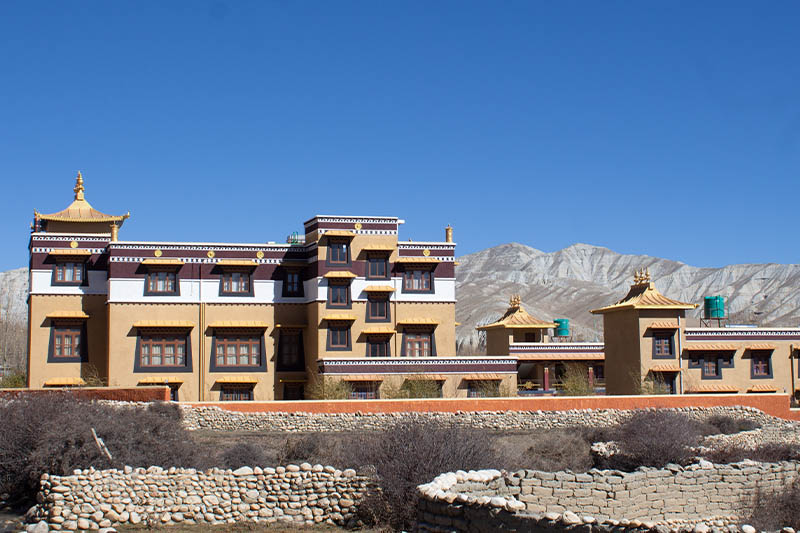
Locals have attempted to protect these structures by covering them with plastic or zinc sheets, similar to what they do with their own homes. "The unused ancient gumbas will collapse due to lack of preservation within a few years. Their existence is in jeopardy," she stated.
Mustang is among the places that faces the risks of multiple disasters – the melting of the glaciers, floods and mudslides, among others.
More rains, more danger
According to statistics from the Office of Hydrology and Meteorology, Pokhara, the maximum annual rainfall in Upper Mustang was below 200 millimeters until 2009, as recorded by the Weather Station located in Chhosare, Lo Manthang Rural Municipality-1. Since then, the amount of rainfall has consistently increased. In 2023, the rainfall reached 331 mm.
Similarly, records from the Weather Station in Jomsom indicate that the maximum rainfall until 2010 was below 300 mm, but by 2023, it had risen to 665 mm.
Data from the Department of Hydrology and Meteorology shows that the annual average temperature in Nepal is increasing by 0.056 degrees Celsius, which, although seemingly insignificant, has begun to have a substantial impact. According to the International Centre for Integrated Mountain Development (ICIMOD), while the global temperature is rising at a rate of 1.1 degrees Celsius, the rate of snowmelt in the Himalayan region is rapid.
Prabin Man Singh, a climate change expert who has also served as the director of Prakriti Resource Center, explains that Mustang's topography is not suited to withstand heavy rainfall. While 50 mm of rain is considered normal in Pokhara, the same amount of rain in Lo Manthang within an hour can lead to unimaginable loss and damage. Therefore, Singh warns that increasing rainfall in Mustang is a sign of danger. "Mustang is essentially a place with mud houses. Now that heavy rain has started there, where it used to be very rare in the past, it has saturated the mud structures, and rooftops have begun to leak. The unique appearance of the houses has started to disappear. When hot weather became common, traditional attire like Bakkhu vanished," he said.
Karma Namgel, the ward chair of Lo Manthang Rural Municipality-2, has witnessed the drastic change in weather patterns in Mustang. In his younger days, there would be as much as four feet of snow in November and December. However, this year, there was very light snowfall in February. Mustang, traditionally known as a town of snow, has begun to experience low snowfall.
In the last two decades, low snowfall has led to early melting of snow which has led to rise of temperature. Rising temperature has meant that there is more rain which wets the mud strictures and which finally pushes them to collapse.
Need for preservation
Each year, over 4,000 international tourists embark on an adventurous trek to the Mustang mountains to witness its cultural heritage. According to data from the Lo Manthang Office of ACAP, 3,484 foreign tourists visited Upper Mustang in 2023, and 4,061 made the journey to these Himalayan wonders in 2024. Domestic tourists, for whom ACAP does not have data, also contribute significantly to the visitor numbers. This increasing human presence could pose a challenge to preserving the archaeological town. Nasi Narbu Gurung, the Chair of Lo Manthang Rural Municipality, emphasizes the necessity of preserving the caves and gumbas. "Tourists flock to Upper Mustang to observe ancient civilization. Locals are also earning some income, but this has raised concerns that it could present a significant challenge to preservation efforts," he stated.

Lopsang Chhomphel Bista, the chair of Loghekar Damodarkunda Rural Municipality, mentions that his municipality is developing a work plan to protect residents from climate change impacts and to safeguard the heritage. Archaeological Officer Devendra Bhattarai argues that measures must be explored to preserve the mud city, as the gumbas and palaces of Upper Mustang are bearing the brunt of climate change.
"As the rainy season is extending in Mustang, locals are seeking alternatives to mud structures, opting for concrete. Instead of using zinc sheets on the roofs of palaces and gumbas for protection and instead of building concrete houses, it would be better to use bitumen waterproof tar felt on the house roofs," he suggested.
Nabha Basnet Thapa, the chief of the Cultural Division at UNESCO Nepal, states that a study on the impacts of climate change in Lo Manthang has yet to be conducted, but discussions regarding the preservation of Mustang's heritage are ongoing. "Locals bear the primary responsibility for preserving the heritage of archaeological value. If external assistance is needed for preservation, UNESCO is ready to provide support," Thapa said.
This story was produced under the NIMJN-CANSA Fellowship Program. Please adhere to our republishing policy if you'd like to republish this story. You can find the guidelines here.

